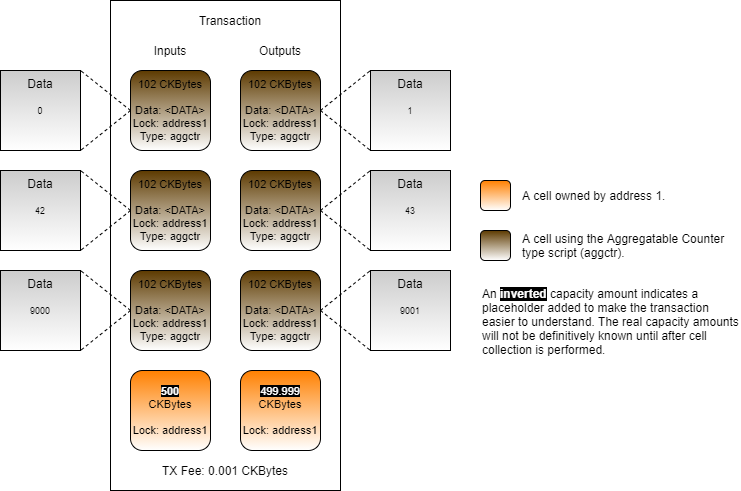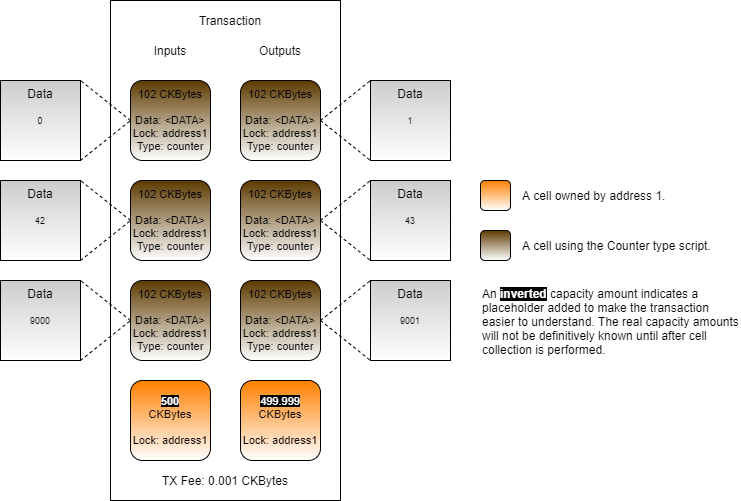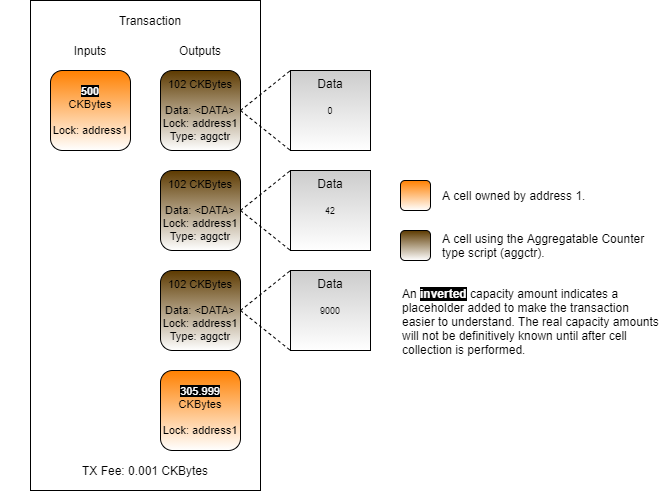Creating Aggregatable Scripts
One of the unique features of the Cell Model is that multiple cells can be combined into a single large transaction instead of creating separate small transactions. This process is called "aggregation". However, aggregation is only possible when scripts are programmed in a way flexible enough to allow it. In this lesson, we will demonstrate some of the basic principles of creating aggregatable scripts.
Minimal Concern Pattern
One of the most common ways to create an aggregatable script is to follow the minimal concern pattern. Following this pattern creates scripts that have composable cell logic that allows them to safely be combined in a single transaction with other cells of different types without affecting their operation.
To incorporate the minimal concern pattern a script should:
Process all cells in the current script group.
Allow any number of cells in the script group.
Ignore any cells that are not in the same script group.
Ignore extraneous data outside the scope of what is used.
In essence, a script should only check the minimal amount of information needed to ensure the validity of the cells it is concerned with validating.
Script Logic
Next, we will show an example of an Aggregatable Counter type script. But first, we will start by reviewing the pseudo-code for the original Counter type script as a quick refresher.
Now, let's take a look at what a transaction would look like if it contained multiple Counter cells.
This transaction would not execute successfully because the Counter type script would give an error. The offending lines in the pseudo-code would be 9 and 10. The Counter type script was only designed to process exactly one input and one output.
We need to update the script logic to be able to handle multiple cells. Here is the pseudo-code for the Aggregatable Counter.
The code starts out the same as the regular counter. On lines 3 and 4, we count the number of group input cells and group output cells. On lines 6 and 7, we immediately succeed if there are no input cells which allows for the creation of new Counter cells.
On lines 9 and 10, we check that the counts match 1:1. This is necessary in order to match up the inputs with the outputs and locate matches, but we no longer restrict the transaction to having one input and one output.
On line 12, we loop through each cell index.
On lines 14 and 15, we load the cell data from the inputs and outputs at the current index, then we convert the data from binary to integer values.
On lines 17 and 18, we compare the input value and the output value to ensure the output value is exactly one higher. If this is not a match, we return an error.
On line 21, we return success if no errors have occurred.
This code can take any number of Counter cells. The requirements are that while updating there must be one input for every output and that the updated output value for an input value must be at the same index.
Here is the real version in Rust.
The dependencies and boilerplate code are the same in this example as in the previous lessons, so we won't go over them. We'll only go over the main logic of the code.
On lines 15 to 29, we count the group input and group output cells, then perform some basic validation. The Aggregatable Counter type script uses the GroupInput and GroupOutput. This limits the scope of concern to only other Aggregatable Counter cells. It then checks the number of input cells, which is logically checking if the operation is creating cells, or updating cells. It then checks that the number of input and output cells is equal. This ensures that we have the proper structure to validate an update operation.
On line 32, we loop through all the cell indexes. On lines 35 and 36, we retrieve the data for the group input cell and group output cell at the current cell index.
On lines 38 to 46, we convert the input and output data to u64 values.
On lines 48 to 53, we check that the values are as expected, and return an error if it is not as expected.
On line 57, we return successfully if no errors were found.
Usage in Lumos
Next, we will use the Aggregatable Counter type script in a Lumos example. Our code will deploy the type script code, create some cells using the Aggregatable Counter type script, then update the values of those cells.
The code we will be covering here is located in the index.js file in the Creating-Aggregatable-Scripts-Example directory. Feel free to open the index.js file and follow along. This code example is fully functional, and you should feel free to modify and experiment with it. You can execute this code in a console by entering the directory and executing node index.js.
Starting with the main() function, you will see our code has four sections.
The initialization and deployment code is nearly identical to the previous examples, so we're not going to go over it here. Feel free to review that code on your own if you need a refresher.
Creating Cells
Next, we will look at the relevant parts of the createCells() function. This function generates and executes a transaction that will create cells using the Aggregatable Counter type script.
This block of code creates three Aggregatable Counter cells. This is very similar to the previous lesson, except that we are creating multiple cells now.
On line 2, we loop through the amounts that want to create cells with. This is the starting value for the Aggregatable Counter. Our script code does not restrict the starting value, so we can customize the starting point.
On line 12, we convert that amount into a u64 LE value in hex bytes and insert it into the cell structure on line 13, which is then added to the transaction on line 14.
The resulting transaction will look similar to this.
Updating Cells
Now, we'll look at the relevant parts of the updateCells() function. This function generates and executes a transaction that will update the Aggregatable Counter type script's state.
This adds the existing Aggregatable Counter cells as inputs to the transaction, using the given out points from the previous transaction.
On line 2, we create an array to keep track of the values in each cell.
On line 5, getLiveCell() contains a third parameter set to true. This is a flag indicating that data should be returned with the cell that is returned. Retrieving a cell and retrieving the data for a cell requires two different system calls, so we only request the data if it is needed.
On line 6, we take the data from the input Aggregatable Counter cell and decode it from hex-encoded binary to a BigInt. These values will be used again during the creation of our output Aggregatable Counter cells.
This code creates the output Aggregatable Counter cells with the updated values. This code is very similar to the code in the createCell() transaction, except we update the value on line 12.
The resulting transaction will look similar to this.
We can update as many cells as needed in a single transaction, rather than having to create multiple transactions. This reduces the overhead involved with a transaction and on script execution since it is more efficient to have a script execute once and process multiple cells than it is to have a script execute multiple times to process a single pair of cells. This, in turn, reduces the computation cycles required and saves on transaction fees.
Last updated



